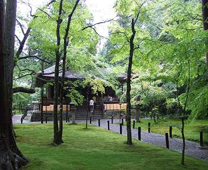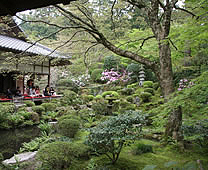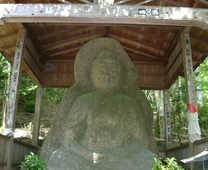
Travel Guide
Introduction
Sanzenin Temple, also called Sanzenin Temple Monseki, is one of the five Tendai Buddhism Monzeki temples. Sanzenin Temple is highly ranked in the Tendai sect because many Tendaizasu, chief priest of the Tendai sect head temple Enryakuji Temple, is from the temple.
The temple is famous for its large garden where an old wooden sub-temple sits in what looks like a still sea of green moss, penetrated by a few tall cedars and carefully-placed rocks and shrubs. Elsewhere on the grounds are ponds stocked with colorful carp, stone statue of Jizo, the protector of children and souls in limbo, and a hillside filled with rocks, shrubs, and trees.
The garden is in its glory in autumn when large crowds gather to witness the fall colors. During any season however, Sanzenin Temple is worth a visit, as much for its statuary as its scenery. The temple enshrines a famous statue of Amida Buddha with two kneeling attendants.
Attractions
After entering the temple through the front gate, visitors to Sanzenin Temple pass through a series of connected temple buildings.
The first major building is the Kyakuden (guest hall). In the Kyakuden, ancient texts and paintings on sliding door panels are displayed. These works of art were painted by the great artists of Japan, including Suzuki Shonen and Takeuchi Seiho, who are representative of Kyoto's art world in the Meiji era. The building opens up onto the Shuhekien Garden, a traditional Japanese garden that has a small pond and hill.
Connected to the Kyakuden by a corridor is the Shinden. In the Shinden, memorial services have long been held by the chief priest. On May 30th every year, this hall serves as a center for Osenboko (a service with Shomyo), which has been a tradition since the time of the Emperor Goshirakawa. From the Shinden visitors can enjoy the most famous view of Sanzenin Temple: the Ojo Gokurakuin Hall seen through maple and cedar trees across a moss garden called Yuseien garden.
After admiring the view from the Shinden, visitors walk through the Yuseien garden. A tranquil atmosphere permeates the garden, and there are a number of amusing stone statues that peek out from the moss. Along with the rest of the temple, the garden is particularly impressive during the autumn colors, which usually take place in mid November, about a week earlier than in central Kyoto.
After passing through the Yuseien garden is Ojo Gokurakuin Hall (main hall). Ojo Gokurakuin Hall is the oldest temple building at Sanzenin Temle. The hall was first built in 985 and most recently rebuilt in 1143. Inside the hall are hollowed ceiling and walls, decorated with a depiction of a heavenly garden called Shuhekien garden, in full color. It holds a statue of Amida Buddha, Sanzenin Temple's most valued National Treasure. The statue of Amida is accompanied by two attendant deities, Kannon on one side and Seishi on the other.
From the Ojo Gokurakuin Hall there is a path that leads to the back of the temple grounds, where there are a few temple buildings of more recent construction. One interesting spot has rows of miniature statues of Kannon that were donated to the temple by visitors. On the way back to the front gate stands a treasure house that displays a few more of Sanzenin's artifacts.
History
Denkyo-daishi Saicho (767-822), the founder of Hieizan Enryakuji, built a small hall called En'nyu-bo in Todo of Enryakuji in the year 788. This is said to be the origin of Sanzenin.
Sanzenin became a monzeki temple in 1130 when the second son of Emperor Horikawa became the 14th head priest. While a nun called Shin'nyobo-ni founded Jogyozanmaido (present day Ojo Gokurakuin) in Ohara in 1148. This temple was incorporated into Sanzenin in Tenmon era (1532-1555).
In the mid 12th century, many invocation-chanting-monks lived in Ohara and the monzeki temple set up mandokoro to govern them. This governing body eventually became the present day Sanzenin. The temple moved in to mandokoro, the present site, in 1871 after changed its site several times. The name was changed to Sanzenin at that time. Ojogokuraku-in had been separated from Sanzenin for a while but incorporated into Sanzenin again when the temple moved in.
 |
 |
 |
| Ojo Gokurakuin Hall | Kyakuden and Shuhekien garden | Stone statue of Jizo |
Travel Advice
|
|||
Visit
| Address | 540 Ohara-raigoin-cho, Sakyo-ku, Kyoto-shi, Kyoto | |
| Phone | 075-744-2531 | |
| Admission | Adult: 700 yen Junior high: 400 yen Elementary: 150 yen |
Adult: over 15 Group tickets are available |
| Hours | 09:00 to 17:00 08:30 to 17:00 Nov 09:30 to 16:30 Dec to Feb |
|
| Closed | Open 7 Days a Week | |
| Duration | 30 minutes | |
| Getting There | By Train 60 minutes ride by City Bus No.17 or 208 bound for Ohara from JR Kyoto Station to the Ohara bus stop, then walk approximately 10 minutes. Take City Bus No.10, 16 or 17 from Demachiyanagi Station on Keihan Electric Railway Keihan Honsen to Ohara bus stop, then walk approximately 10 minutes. Take City Bus No.19 from Kokusaikaikan Station on subway Karasuma Line to Ohara bus stop, then walk approximately 10 minutes. By Car Take Meishin Expressway to the Kyoto-higashi exit. It is approximately 60minutes from exit. |
|
| Parking | No parking available | |

